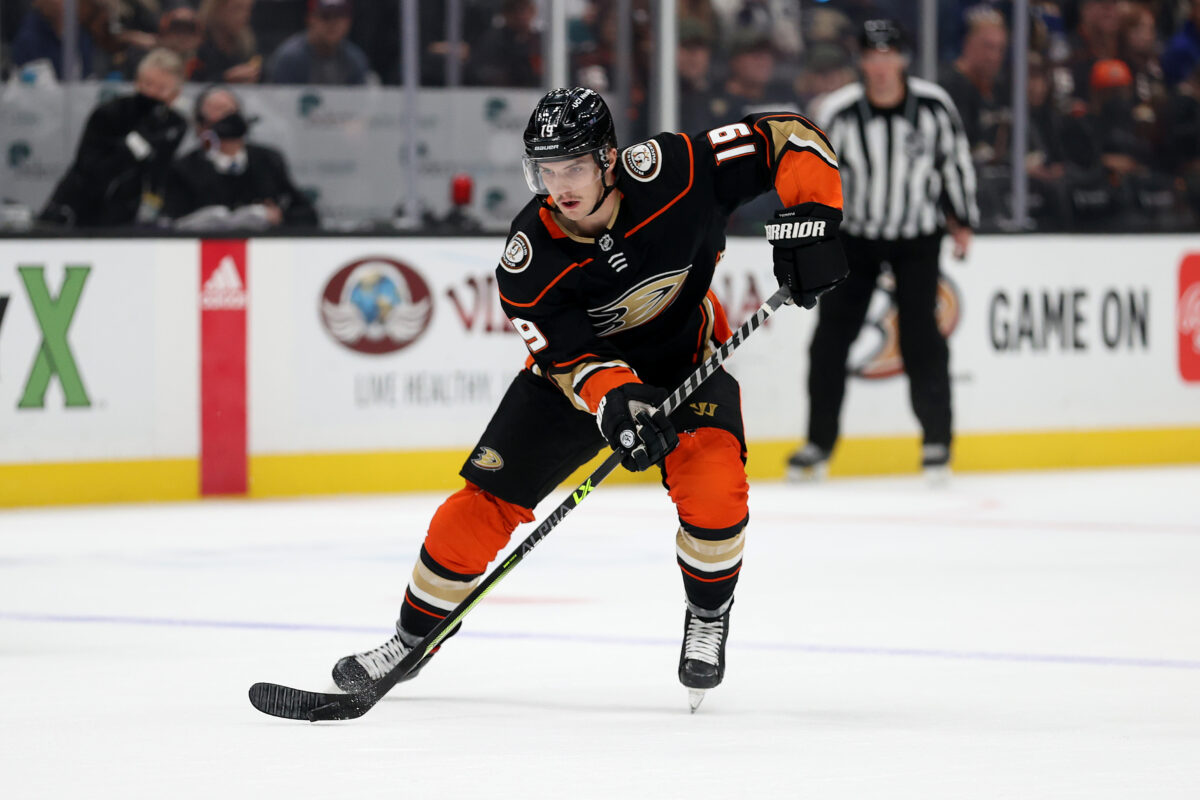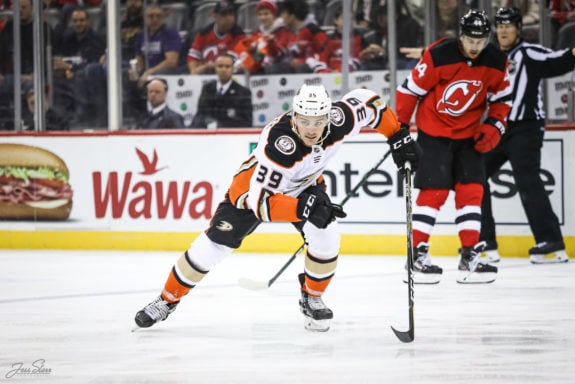There was no shortage of talking points after the Anaheim Ducks’ 5-0 victory over the Arizona Coyotes on Friday night. Trevor Zegras scored his second career Michigan-style goal, adding style points by wrapping around teammate Sonny Milano in the process. Anthony Stolarz had his third shutout of the season, and the new top line of Zegras, Milano, and Troy Terry had another incredible evening.
These takeaways and highlights quickly became subplots after what happened in the final minutes of the game. The Ducks had a 5-0 lead with just under six minutes remaining when Coyotes goaltender Josef Korenar thwarted an attempt from Milano to bring the puck from behind the net to a waiting Zegras. The puck was buried between Korenar’s legs but was awkward enough that Zegras believed the puck was still loose, a claim he continued to make after the game. His determination earned him a cross-check in the back from Coyotes center Jay Beagle, and a scrum ensued. Terry was the first Ducks player to come to Zegras’ defense, and Beagle unloaded a series of punches that sent Terry to the ice without having dropped his gloves.

Terry is not a fighter and, at 6-foot-1, 175 pounds, will never be confused for one. As a result of the one-sided fight, Terry exited the game with a head injury that forced him to miss the Ducks’ game against the Edmonton Oilers on Sunday night, and his status remains uncertain.
Related: Anaheim Ducks News & Rumors: Terry, Aston-Reese & More
The fact that this happened after the Ducks traded Nicolas Deslauriers to the Minnesota Wild was not lost on anyone. Deslauriers was an enforcer, an unofficial role that’s had a place in hockey for decades. Enforcers exist to keep the peace with the threat of violence. The argument is that a team will be less likely to take a shot at another team’s star player if someone like Deslauriers, one of the league’s more willing pugilists, is in the lineup.
There’s been plenty of chatter, including from Ducks legend Teemu Selanne, that the young group of Ducks players need someone to watch their back (CONTENT WARNING: link shows Terry’s face in the aftermath of the fight). The problem is, an enforcer wouldn’t have been able to prevent what happened to Terry, and it happened late enough into the game that Beagle would not have received his comeuppance after the fact.
Enforcers Stifle Innovation
This was the second game that the Ducks used the Terry-Milano-Zegras line, aptly dubbed the ‘TMZ’ line. It’s a stacked, offensive-minded trio that has generated 2.35 expected goals for (xGF) in just 36 minutes together. This is the first issue in assuming an enforcer would have prevented Terry’s injury. Bench-clearing brawls have been outlawed and face a minimum 10-game suspension. In order for an enforcer to stop what Beagle did to Terry, that enforcer would have to be on the ice, and if that enforcer was a forward, he’d have taken the place of a skilled player on the top line.
Often, the need to protect players stifles innovation. Head coach Dallas Eakins has toyed with the line combinations throughout the season, including stints when Deslauriers would play alongside Zegras. Deslauriers was skating on Zegras’ line when PK Subban of the New Jersey Devils slew-footed Zegras in early November. Despite that Deslauriers was on the ice, the only punishment Subban received was a $15,000 fine from the league. Having an enforcer on Zegras’ line would sacrifice production for protection, and if the protection can’t be guaranteed, then what’s the point?
Sam Carrick Can Enforce and Score
Even without Deslaurier, the Ducks are capable of sticking up for themselves. Sam Carrick has been credited with as many fights as Deslauriers and has a little more offensive upside. Carrick has been one of the quieter revelations on the team this season. He was captain of the San Diego Gulls of the American Hockey League before this season and seems to have found a regular spot in the Ducks’ lineup.

Carrick was already serving a fighting major when the conflict between Beagle and Terry broke out. Having someone like him in the lineup should be enough deterrent that opposing teams won’t take a run at some of the younger Ducks. But Anaheim should also avoid feeling the need to add muscle in free agency that would take a spot from a higher-upside prospect.
Ducks Can’t Overreact to Another Team’s Emotions
The incident between Terry and Beagle was the result of a perfect storm. The Coyotes were frustrated with what led to a 5-0 deficit, and it reached a boiling point when Zegras started to jab at a potentially loose puck. Beagle’s game misconduct penalty with only a few minutes remaining meant no on-ice justice could be served, and, at 36 years old and on an expiring contract, he’s likely rounding out his final season in the NHL.
Beagle’s frustrations were echoed by Coyotes television analyst Tyson Nash. Nash, who averaged 0.17 points per game and 1.8 penalty minutes per game in his NHL career, implied that the Ducks’ use of skill throughout the game warranted Beagle’s reaction. Beagle also spoke the next day, claiming that the fight was initiated the moment Terry grabbed at him. Terry, while still young, is a veteran of nearly 200 NHL games and seemed to be unaware of that “unwritten rule.”
While it is frustrating to see Terry remain sidelined and Beagle continue to play, it is important to see the forest for the trees. With an active trade deadline that saw a handful of veterans swapped for future draft picks, the Ducks are built to contend in the near future. Terry reached the 30-goal mark for the first time in his career this season and can replicate that for years to come. There’s no need for the Ducks to overreact to actions in a late-season game between two low-standing teams just rounding out the season.